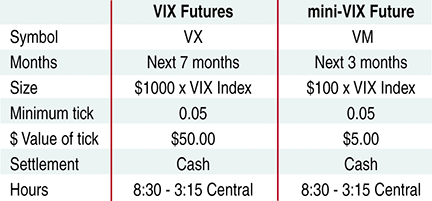TRADING TECHNIQUES
Taking A Position On A Measure Of Fear
Trading Volatility
The Cboe Volatility Index has been used as a measure of fear in the market, but there’s more to it than that. Find out how you can use the Vix to take a position when you have an opinion about the direction of volatility in the equity market.
Throughout the stock market goofiness in the second half of 2008, we were constantly told there was panic and the high level of the Cboe Volatility Index (Vix) was cited. If you were even just a passive viewer of Cnbc or any business program, you got the impression that the Vix was a measure of fear and the higher the Vix went, the more frightened investors became.
There is a lot more to Vix than using it to tell the public there is fear in the market. In fact, there are ways that traders can take a position when they have an opinion of the future direction of volatility in the equity market.
A quick VIX history
The history of the Cboe volatility index stretches back to 1993, when Robert Whaley of Vanderbilt University published a paper on calculating volatility. His methodology in 1993 was to measure the stock market’s expectation of a 30-day volatility that was implied by at-the-money Standard & Poor’s 100 or Oex option prices. In 2003, the Cboe along with Goldman Sachs updated the Vix to reflect a new way to measure expected volatility. This new method involved calculating market volatility through averaging the weighted prices of S&P 500 (Spx) puts and calls over a range of strike prices. The updated calculation also takes pricing from two expiration dates instead of just the closest expiration date.
With the popularity of the Vix as a market monitoring tool, the Cboe introduced a variety of volatility measures to the marketplace. The Cboe now calculates and publishes data on several other stock market indexes, including the Cboe Nasdaq 100 volatility index (Vxn), Cboe Djia volatility index (Vxd), and the Cboe Russell 2000 volatility index (Rvx). Finally, in 2008 the exchange branched out into measuring volatility to include alternative investments through the Cboe crude oil volatility index (Ovx), Cboe gold volatility index (Gvz), and the Cboe eurocurrency volatility index (Evz).

Figure 1: vix and mini-vix. Here you see the contract specifications for the VIX and mini-VIX futures contracts.
Trading the VIX
Most traders have heard of the Vix, especially about the incredible levels it reached at times in 2008. However, there are some who are not aware that there is a variety of ways to trade expectations of the Vix.